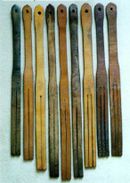Striking the hand
Striking the hand is a method of corporal punishment in which the delinquent's hand is punished by slapping or striking it with one's own hand or an implement such as a switch, cane, strap, tawse, wooden spoon or ruler. When a cane is used, it is called a hand caning.
This punishment method is typically used on children in schools and by parents at home. It ranges from gently slapping a toddler's hand when he touches something forbidden (a case of punishment on the point of offense), up to severe punishment with very painful implements such as a Lochgelly tawse.
Method
Usually when a hard implement is used, only the palms are the target of this punishment as they are better padded than the back of the hand. Sometimes the fingers are hit (which hurts more as they are more sensitive), and sometimes the tips of the fingers (which hurts most). If the backs of the hand(s) are hit, the pain is even more, but this can easily cause damage and injury because the bones and joints of the hand and fingers will be hit.
The delinquent child is usually told or ordered to hold out his hand(s) for the punishment and to keep it still for the announced number of strokes (typically three to six strokes per hand). Sometimes the child has to count the strokes, while other times the adult will speak out a lesson to the child (such as "Speech is silver; silence is golden") while striking the hand, one stroke per word.
It is (or was) believed that the fact that the child has to actively co-operate with their punishment helps to strengthen self-control and self-discipline.
Comparison to spanking
Compared to spanking, this punishment method may be less degrading, but hurts more and is also more likely to cause injury if the implement is heavy or many stroks are delivered. This punishment method may sting more than spanking if the weather is freezing. It is also quite cruel because the child has to actively cooperate and watch his hand being struck. This is also combined with the fact in school, the child will be expected to return to the task they were meant to be doing, such as writing, made much more difficult by their sore hands. However, striking the hand with a lighter implement and with a few stokes may be considered a punishment lighter than spanking.
In Chinese cultural zones (e.g. Taiwan), when the delinquent is a school-age or older girl instead of a boy, a disciplinarian tends to strike her hand(s) instead of her buttocks because striking a girl's buttocks is sometimes considered degrading, even worse, (sexually) abusive. In the same culture, if the disciplinarian is female and the delinquent is a school-age or older boy, the disciplinarian also tends to strike the delinquent's hand(s) instead of his buttocks, however, this is mostly for the disciplinarian's modesty, not the delinquent's dignity. Though a mother seldom hesitates to spank her son if the son is under the age of puberty.
| List of Spanking Implements |
|---|
|
See "sting and thud" for more on this distinction. |
Chat rooms • What links here • Copyright info • Contact information • Category:Root
